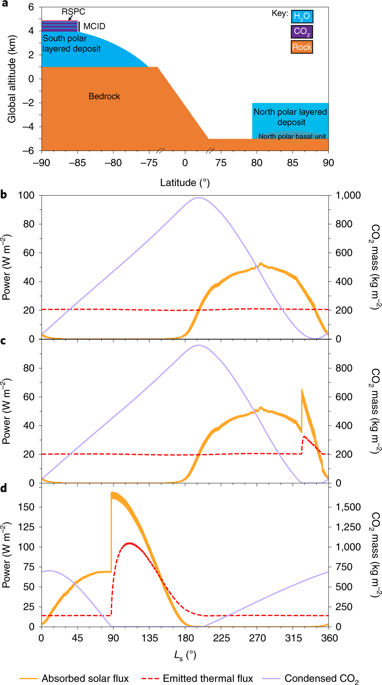Nature Astronomy ( IF 12.9 ) Pub Date : 2019-12-23 , DOI: 10.1038/s41550-019-0976-8 P. B. Buhler , A. P. Ingersoll , S. Piqueux , B. L. Ehlmann , P. O. Hayne

|
A massive CO2 ice deposit overlies1 part of Mars’s primarily H2O ice2,3,4 south polar cap5. This deposit rivals the mass of Mars’s current, 96% CO2, atmosphere6. Its release could substantially alter Mars’s pressure and climate1. The deposit consists of alternating CO2 and H2O ice layers to a depth of up to approximately 1 km (refs. 1,7,8). The top layer is an enigmatic9,10,11 1–10 m covering of perennial surface CO2 ice12 called the residual south polar cap. Typical explanations of the layering invoke orbital cycles1,7. Up to now, models assumed that the H2O ice layers insulate and seal in the CO2, allowing it to survive high-obliquity periods7,13. However, these models do not quantitatively predict the deposit’s stratigraphy or explain the residual south polar cap’s existence. Here we present a model in which the deposit’s near-surface CO2 can instead exchange with the atmosphere through permeable H2O ice layers. Using currently observed albedo14,15 and emissivity16 properties of the Martian polar CO2 ice deposits, our model predicts that the present massive CO2 ice deposit is a remnant of larger CO2 ice deposits laid down during periods of decreasing obliquity that are ablated, liberating a residual lag layer of H2O ice, when obliquity increases. Fractions of previous CO2 deposits remain as layers because the amplitudes of the obliquity maxima have been mostly decreasing during the past ~510 kyr (ref. 17). Our model simultaneously explains the observed massive CO2 ice deposit stratigraphy, the residual south polar cap’s existence and the presence of a massive CO2 ice deposit only in the south. We use our model to calculate Mars’s pressure history and determine that the massive CO2 ice deposit is 510 kyr old.
中文翻译:

火星大气层与南极大量CO 2冰层共同演化
一个大规模的CO 2冰存款覆盖1个火星的主要H的部分2 ö冰2,3,4-南极帽5。该沉积物可与火星目前的96%CO 2气氛6相比。它的释放可能会大大改变火星的压力和气候1。该沉积物由交替的CO 2和H 2 O冰层组成,深度可达约1 km(参考文献1,7,8)。顶层是一个神秘的9,10,11 1–10 m覆盖多年生表面CO 2冰12称为残留南极帽。分层的典型解释调用轨道周期1,7。到目前为止,模型假设H 2 O冰层在CO 2中绝缘并密封,从而使其能够在高倾角时期生存7,13。但是,这些模型不能定量地预测该矿床的地层学,也不能解释残留的南极帽的存在。在这里,我们提出一个模型,其中矿床的近地CO 2可以通过可渗透的H 2 O冰层与大气交换。使用当前观察到的火星极地CO 2的反照率14,15和发射率16特性冰沉积,我们的模型预测,目前的大量CO 2冰沉积是倾斜减少的时期被消融时沉积的较大的CO 2冰沉积的残余,当倾斜增加时,会释放H 2 O冰的残留滞后层。以前的CO 2沉积物的馏分保留为层,因为在过去约510年间,最大倾角的振幅大部分已减小(参考文献17)。我们的模型同时解释了观测到的大量CO 2冰层地层,残余的南极帽的存在以及大量CO 2的存在。冰只沉积在南部。我们使用我们的模型来计算火星的压力历史记录,并确定大量的CO 2冰沉积是510年前的。











































 京公网安备 11010802027423号
京公网安备 11010802027423号